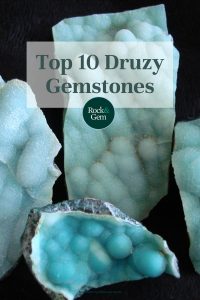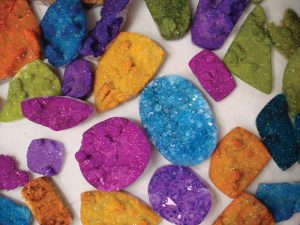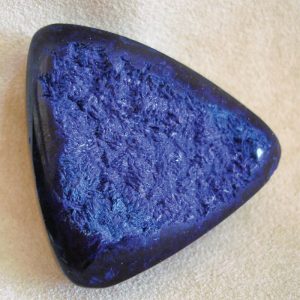
Druzy gemstones are cut from natural mineral specimens packed with very small crystal surfaces that reflect light and create a dazzling appearance. The generic term druzy (also called druse, or drusies) describes fine crystal mineralization. The term druzy does not pertain to only one mineral species but to any mineral variety that displays this type of crystal arrangement.
Druzy Gemstone Characteristics

The shimmering effect, with clusters of tiny crystals present, is sometimes described as the sparkling of sugar or snow. The size of the crystals may range within a few millimeters, and in general, the smaller-sized crystals produce a better glistening effect. Druzy gemstones may cover, or encrust, all or part of rock surfaces, commonly inside vugs and cavities. The druzy surfaces usually differ mineralogically from the background matrix in which the crystals are embedded. That matrix varies from hard agate to softer and more fragile rhyolite, sandstone, or limestone.
The druzy craze started about 25 years ago when American-cut druzy gemstones made their debut on the market, and today, druzy gems are more popular than ever. Jewelry customers are drawn to the sparkling natural, unpolished mineral surfaces. Everyone loves wearing a little sparkling gem.

Photo by Helen Serras-Herman
Natural and Enhanced Druzy Gemstones
The majority of druzy gemstones are of natural origin, but some have undergone enhancement treatments such as permanent dye or have been enhanced with Opticon® fracture sealer, a treatment that should always be disclosed to the customer for proper care.
Many druzies (mostly druzy quartz), are also coated with titanium or precious metals including genuine 18-karat yellow gold, 14-karat rose gold, silver, or platinum. Customers should be advised that the coating, can be scratched or chipped off if the stone is dropped and that the damaged stones should not be re-polished. Cleaning natural druzy in an ultra-sonic machine works great, but not if they are coated. It is best to simply clean those druzies with warm, soapy water and then blow-dry them.
Lapidary Work With Druzy Gemstones
Druzy gemstones do not strictly fall under the cabochon category because they don’t have a domed top surface, but have created their own lapidary category. They may be cut as flat freeforms, or drilled to be strung as beads, pendants, and earrings. Druzy gemstones are often cut in a “window druzy” style with a highly-polished surface encircling and protecting the druzy surface within. The sides of the drusies are often beveled for an easy bezel setting. The juxtaposition of druzy to highly polished or matt surfaces creates a striking textured effect.
Druzy gems are often cut from geodes that secrete mineral microcosmos, some complex three-dimensional mineral landscape scenes. Lapidaries should be careful with high-projecting mineralization as it may not be best worn as jewelry. Lapidaries and jewelry designers value uniform surfaces of smaller-sized crystals, as they pose fewer problems in cutting and setting the stones. Also preferred are drusies with a tightly-packed field of crystals, with no barren matrix surface.
Artistic fantasy cuts, including leaves, stars, crosses, snowflakes, or hearts, are in vogue, but basic symmetric shapes like rounds, ovals, and free forms for matched pairs are still in demand.
Top 10 Natural Druzy Gemstone Varieties

Photo by Helen Serras-Herman
1. Natural Druzy Quartz- forming on top of agate is perhaps the most common druzy material and was among the first materials used for druzy gemstones. Druzy quartz on agate is commonly found in gray colors, but occasionally in stark white, natural black, orange, and lavender. Rare is the occurrence of black or brown dendrites (usually manganese inclusions) on top of the druzy. Natural druzy quartz can undergo permanent dying. It absorbs the dyes easily and is usually dyed in bright neon colors. Thus making natural druzy quartz identification difficult.
When neon-blue colored chrysocolla penetrates clear quartz or chalcedony, it forms the rarest, most desirable, and valuable
2. Chrysocolla-in-Quartz- Also known as gem silica. The most sought-after are the fine druzy or botryoidal chalcedony formations, in gemmy bubbly shapes. The best material comes from the Arizona copper mines – the famous Inspiration and Ray Mines, near Globe, some of which are closed and only old-mined material is available.
3. Pink Colbalto-Calcite- Also known as cobaltoan calcite, is often called pink druse. It is a vibrant hot pink to reddish-purple color and is from the Kolwezi District in the Democratic Republic of Congo. Sometimes it may exhibit beautiful green inclusions of malachite.
4. Uvarovite– One of the rarest members of the garnet group. Uvarovite almost always exhibits a vivid emerald-green color because of its chromium content and a rusty-green color if the titanium admixture is high (Russian Gemstones Encyclopedia, V.V. Bukanov, Granit, St. Petersburg 2006). Uvarovite garnet occurs as minute well-formed crystals on top of a dark matrix of chromium ore (chromite), creating great color contrast.
The mineral was discovered in 1832 by Germain Henri Hess, a Swiss-Russian chemist and doctor. The classic type locality for uvarovite garnet is the Saranovski Mine, in Sarany, in the Urals region of Russia.
5. Blue Chalcedony – A pastel blue variety of cryptocrystalline quartz. The druzy and botryoidal formations from Turkey and Malawi occur mostly as thin flat crusts, with fine mineral crystallization. Usually, the bottom of the druzy blue chalcedony crust has a finely pitted surface which may be left untouched or be sanded down. The botryoidal blue chalcedony’s surface is smooth and glossy with a grapelike or bubbly appearance. Botryoidal blue chalcedony comes from Turkey, Malawi in Africa, Sumatra in Indonesia, and Washington State.
6. Druzy Rainbow Pyrite – A type of natural iridescent pyrite with a metallic luster. Shimmering iridescent colors include gold, green, pinkish-red, and blue. Gemstones with full-spectrum colors fetch a higher value. The druse surface fills the cracks of sandstone geodes called “mud balls.” These silicified mud concretions are found in Ulyanovsk, at the banks of the Volga River, in Russia. In preparing for the lapidary work, it is best to split the mud balls along these cracks and expose the druzy pyrite surfaces.

Photo by Helen Serras-Herman
7. Azurite – a deep blue-colored copper mineral. Crystals form as dark blue prismatic crystals, but more commonly azurite is found in a massive, nodule, or stalactitic form. Azurite is very soft, with only Mohs 3.5-4. Azurite mineral specimens from the legendary Bisbee and Morenci mines in Arizona are the most sought-after. Druzy azurite is often cut with a highly-polished surface encircling and protecting the delicate druzy surface.

8. Smithsonite – A zinc carbonate that is typically found in botryoidal masses, which are often cut as attractive freeform cabs, in a variety of colors such as grayish-blue, pink and yellow. Its hardness is only Mohs 4.5. Smithsonite may be also confused with hemimorphite, as they may have a similar look and could be misidentified by casual identification. Bright turquoise-blue smithsonite comes from the Kelly Mine in Socorro County, New Mexico.
9. Hemimorphite – A zinc-based sorosilicate mineral whose name comes from the Greek hemi, which means half and morph which means shape. Hemimorphite crystals have different crystal terminations at each end. It occurs in various colors, including blue-green, green, white, colorless, brown and yellow.
Hemimorphite also forms in a microcrystalline globular form. A beautiful variety from Wenshan, Yunnan Province in China, displays brilliant neon-blue color with shimmering crystals. It forms in a highly uneven bubbly crust with a soft background matrix, which may present challenges when cutting. Hemimorphite’s hardness is approximately Mohs 5.

Photo by M. J. Colella
10. Liebethenite – A rare copper phosphate hydroxide mineral exhibiting striking, dark leaf-green crystals. It was originally discovered in 1823 in Liebethen, Slovakia. Liebethenite mineral specimens also come from the Democratic Republic of Congo. The liebethenite matrix is probably one of the hardest, containing red cuprite and quartz, which makes it great for a solid bottom surface in the cut stones. Liebethenite resembles stalactites of druzy malachite, which is another copper mineral. However, malachite’s shade of green is somewhat brighter than liebethenite’s. A great collection of malachite specimens is housed at the Arizona-Sonora Desert Museum in Tucson.
Other druzy gems include vanadinite (Morocco), malachite (Arizona, Congo), rainbow hematite (Brazil, Arizona), purple botryoidal chalcedony (Arizona) or grape agate (Indonesia), and psilomelane in druzy or botryoidal quartz (New Mexico, Arizona).
This story about the top 10 druzy gemstones previously appeared in Rock & Gem magazine. Click here to subscribe. Story by Helen Serras-Herman.












